Implementing DevContentOps: Best Practices for Integrating DevOps and Content Management

Amanda Lee
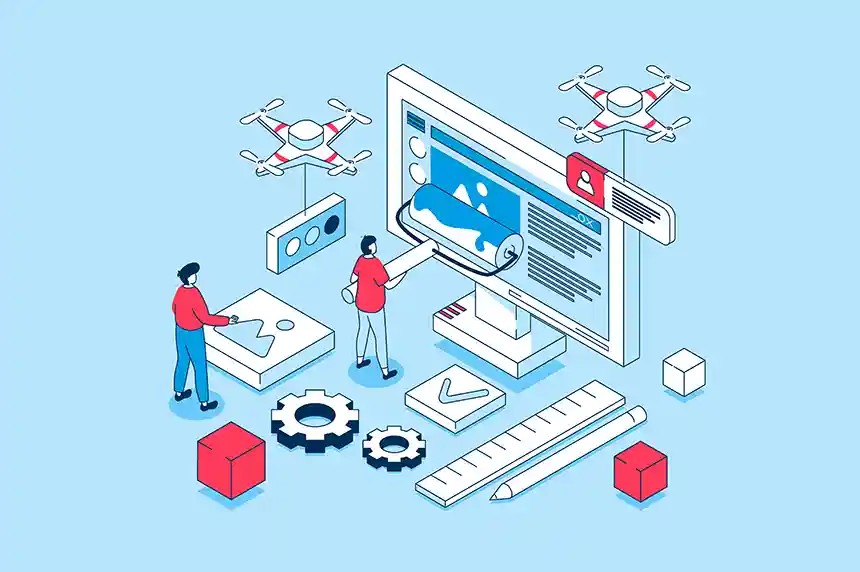
Composing, managing, and delivering digital experiences can sometimes be daunting for enterprises. It requires not only creative skills and technical acumen but also operational expertise and resources.
However, even as enterprises employ multidisciplinary teams to create these experiences, problems are bound to occur without proper unification of their tools and processes that reduce friction and boosts performance.
In this blog, we’ll explore how to avoid those problems by integrating DevOps with content management through DevContentOps processes.
Why Unification of DevOps and Content Management Matters
It’s not uncommon to hear that developers have struggled with ensuring that they’re working with up-to-date content that works seamlessly with the code they produce. Meanwhile, business users need to ensure that content is rendered through the website and that any new content or campaigns set to be launched align with their initial expectations.
To accomplish this, a series of complex tasks and procedures have been implemented to keep content in sync across the various tiers of the CMS. However, there are often problems that occur, including:
- Long delays between syncing environments together
- Misaligned content and code
- Lack of previews before content goes live
Marketing and business teams across the enterprise have taken steps to address these challenges. One of the most common includes launching brand-new sites on lightweight platforms outside the purview of central IT and the enterprise budget. However, this also poses problems.
- These deployments are fast, but there is no integration with those systems and corporate content or core-approved assets
- These rogue deployments are difficult to work with as they begin to evolve
Developers need ways to deliver rich content quickly, and business users need to see quick results and realistic scenarios for the content being deployed. To address this gap, some organizations have cobbled together a series of processes or trained marketing teams to not expect to see realistic content.
Signs Of Unification Issues
Although businesses may seemingly be solving the issues that crop up because of a disconnect between DevOps and content management, many enterprises are walking away from huge investments in web content management in favor of lightweight solutions because they’re struggling to find ways to solve these problems.
Gartner claims, “by 2026, at least 70% of organizations will be mandated to acquire composable digital experience platform technology, as opposed to monolithic suites, compared to 50% in 2023.” This indicates that customers are looking for pieces of the solution, not the whole solution.
Organizations wondering if DevOps and content management are aligned should consider these six key questions:
- Can developers reproduce bugs without opening a ticket to replicate the live environment, which would involve days of work and a DBA?
- Have developers given up on features because they couldn’t test them with accurate data
- Have internal stakeholders been surprised at how their project looked when deployed?
- Can developers reproduce bugs in minutes, or does it take days?
- Is it possible to run shoulder checks with content teams and developers? On demand? With realistic content?
- Is it possible to use a composable plugin system to deploy new enterprise-grade features rapidly and safely?
If the answer to one or more of these questions was no, it could be a sign of much larger unresolved issues.
Benefits of DevContentOps
Unified processes are needed to pull everything together, managing content and code through the course of the lifecycle of a site and deployment. That unified process is known as DevContentOps.
DevContentOps brings the benefits of DevOps to content-driven applications, products, and digital experiences. With DevContentOps, content, and software development teams can collaborate more effectively, publish new content updates faster, release new software features quicker, and deliver higher-performing customer experiences.
When implemented correctly, organizations can realize a number of benefits. Businesses can deploy enterprise-grade features through plugin infrastructures designed for specific purposes.
- Users see changes faster: The content team receives an early view of actual content in a new experience.
- Rapid and predictable deployments: It is possible to deploy enterprise web content management features faster and in a predictable manner.
- Easier diagnostics: Troubleshoot problems in the development environment with actual data in minutes.
- Happier developers: Developers can work with content the way they work with code.
- Streamlined processes: Simple unified processes with a content lifecycle in terms DevOps can understand.
- Standard tools: Content management developers and DevOps work with tools they use every day.
CI/CD/CP
DevContentOps enables us to also extend the concept of Continuous Integration and Delivery or CI/CD, to also include Continuous Publishing.
CI/CD practices allow for the incremental addition of software features, facilitating a more agile response to user feedback and market trends. Enabling the goal of Continuous Publishing - so that content teams can also work at a faster pace, creating, testing, and publishing content on a continuous basis ensures that digital experiences remain fresh, relevant and optimized, enhancing customer satisfaction and engagement.
Read More: Headless CMS Meets DevOps
Why Implementing DevContentOps Is Challenging
Although it may seem straightforward, many organizations struggle with implementing DevContentOps for several reasons. These include the fact that:
- Content schemas evolve. For example, a blog may start out as a simple article, initially with a headline and a body. Later, a byline and read time are added, or one of several other fields.
- Lack of content/code integration: Content repositories are not integrated with the code that backs and delivers them.
- Database challenges: Database dumps for environment synchronization require database specialists.
- Developers work on old data: In-house demos are done with “This is a test” content and fall flat due to unrealistic data.
- Setup challenges: Even in more advanced setups with content backflows, keeping developer content, QA content, and production content in separate streams is hard to do.
The Solution to DevContentOps Unification Challenges
Integrated DevContentOps with code forward/content back solves many of these challenges. With code forward/content back, developers can:
- Seamlessly and naturally migrate content from PROD to QA to DEV to LOCAL systems on demand using standard tools.
- Seamlessly and naturally migrate code from LOCAL to DEV to QA to PROD systems using standard CI/CD practices.
- Leverage Git mechanics for both content and code. Content gets the same dev promotion/deployment tools as code.
- Leverage a simple branching model to provide control and flexibility for both code and content. This allows them to use their own branching model for features, bugs, and more.
The tech lead can determine who gets new content and when. Git users with the correct privileges can perform content back operations on demand. This means no more need for content freezes or long delays and simple conflict resolution approaches.
Automation rules in CI/CD pipelines, like keeping code commits “content free” and triggering automated actions and notifications, are simplified. This enables developers to use the same automation flows they already know and easily deploy sites for feature branches.
Implementing DevContentOps
What does this look like in practice? Here is an overview of steps.
DevContentOps Step 1:
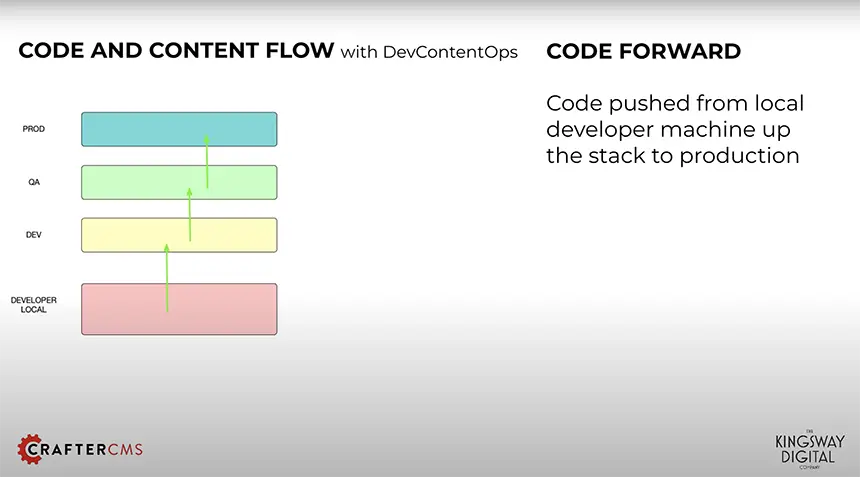
DevContentOps Step 2:
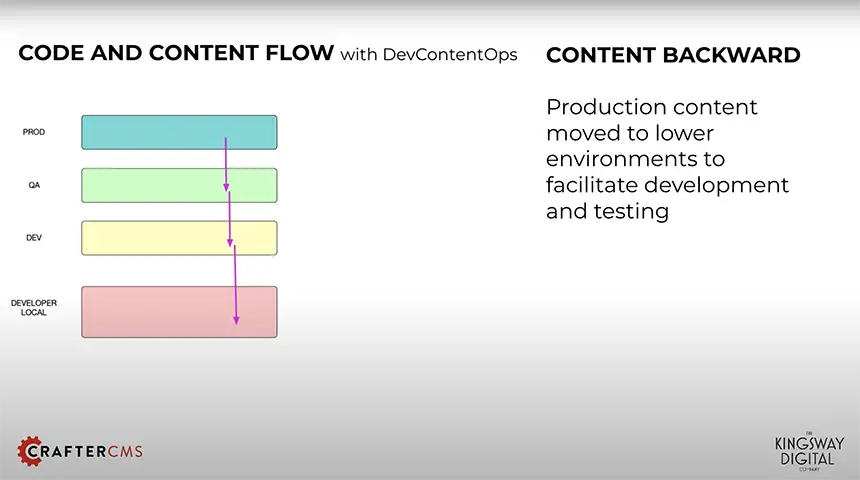
DevContentOps Step 3:
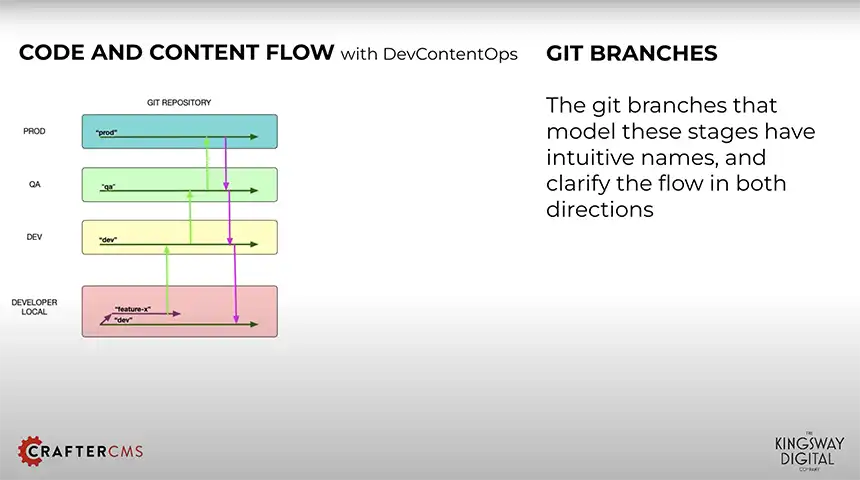
DevContentOps Step 4:
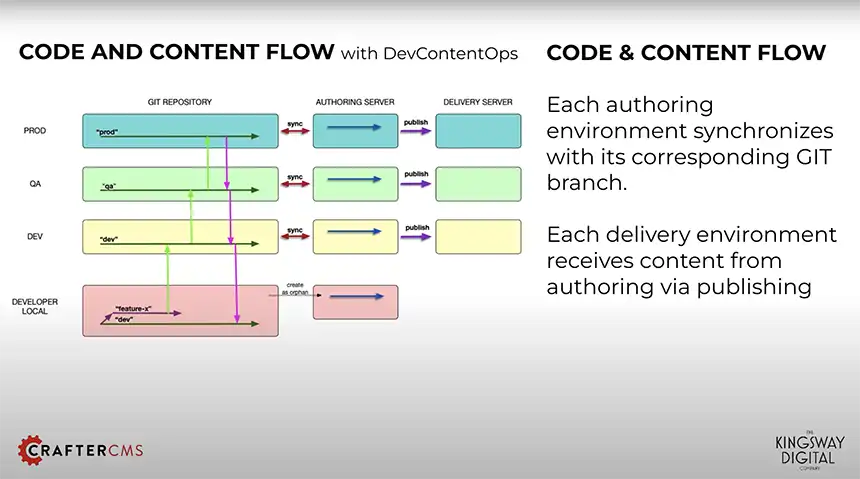
DevContentOps Step 5:

Learn More
To learn more how CrafterCMS uniquely implements DevContentOps processes, watch the recent webcast, Implementing DevContentOps: Best Practices for Integrating DevOps and Content Management, with Tony Field, Chief Solutions Architect at Kingsway Digital, a CrafterCMS certified Solution Partner. You can also read our White Paper: What is DevContentOps?
Related Posts

Websites Are Dead?

Mike Vertal

No-Code Experience Building for Marketers & Designers

Amanda Lee

Is Your CMS MACH-Ready? A Practical Guide for Enterprise Architects

Sara Williams

Composable DXP vs Traditional DXP: Why Enterprises Choose CrafterCMS

Amanda Jones










